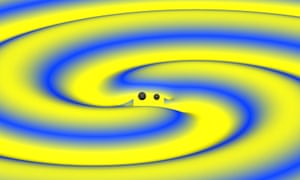
Thursday 1 June 2017 16.41 BST - The Guardian
Latest observation by Ligo brings scientists closer to goal of using gravitational waves to see ancient events invisible to optical and radio telescopes
Numerical simulation of binary black hole merger. Gravitational wave strength is indicated by elevation as well as colour; blue is weak and yellow strong. Illustration: Simulation: S Ossokine, A Buonanno/Visualisation: T Dietrich, R Haas
Ripples in the fabric of spacetime triggered by the cataclysmic merger of two black holes more than 3bn years ago have been detected by physicists.
The observations mark the third occasion that scientists have spotted gravitational waves – the compression and stretching of space itself that was first predicted by Einstein.
Analysis Gravitational waves: why it's impossible not to be thrilled by this discoveryNot only was building this experiment a towering achievement but its success is both stunning and the results totally convincing
The latest detection, by the Laser Interferometer Gravitational-Wave Observatory, or Ligo, has produced intriguing hints on the nature of black holes and, potentially, dark matter.
The faint hum, picked up by Ligo’s twin instruments on 4 January 2017, could be traced back to the violent collision more than 3bn years ago of two black holes with masses of more than 31 and 19 times the mass of the sun, respectively. The two combined to form a single black hole with a mass slightly less than 49 times that of the sun and the leftover energy spilled out as deformations that spread outwards across spacetime like ripples across a pond.
Ligo scientists made the first historic observation of gravitational waves in September 2015, using a pair of 4km-long perpendicular pipes, one in Hanford, Washington state, the other in Livingston, Louisiana. A second detection occurred three months later.
Read more
Summary
Gravitational waves were detected on January and the paper was published weeks ago. It was again at LIGO laboratories. The detection of gravitational waves, which are ripples in the fabric of spacetime that propagate at the speed of light and are caused by the sudden acceleration of massive objects, was, and continues to be a big deal in the cosmological community — it helps to further verify the predictions produced by Einstein’s general theory of relativity. Gravitational waves also give cosmologists and astronomers a new sense, an ability to detect cosmological events that would otherwise go unobserved. Black holes are a little camera shy with being so massive that even light can’t escape their gravity and whatnot.Opinion
This is important because this wave was again produced by the fusion of two supermassive black holes, and now we know that this kind of fusion happens more often than we thought before. This gives us a new tool to study the universe, because gravitational waves can tell us about ancient events that we can't study using electromagnetic waves. The theory would require these two black holes that collapsed to have been formed in the early universe, from patches of material– rather than stars – collapsing inwards. The latest observations reveal the existence of black holes in a “mass window” that would be consistent with this theory.

ELECTROMAGNETIC WAVES turbulence, (photons) colliding against charged particles, photoelectrical effect, of the plasma jets HH which emerge from the black holes central galactic and new young stars in formation, protostars, forming in the jet "knots" more shining each a certain distance... GRAVITATIONAL WAVES (gravitophotons), unknown yet, come from the deep Universe since the beginning of the times. Is not a relativistic affaire "curvature" of that called "space-time"
ReplyDeleteIS THRUTH THAT RELIGION IS LIE, out all religions from the World.
ReplyDelete